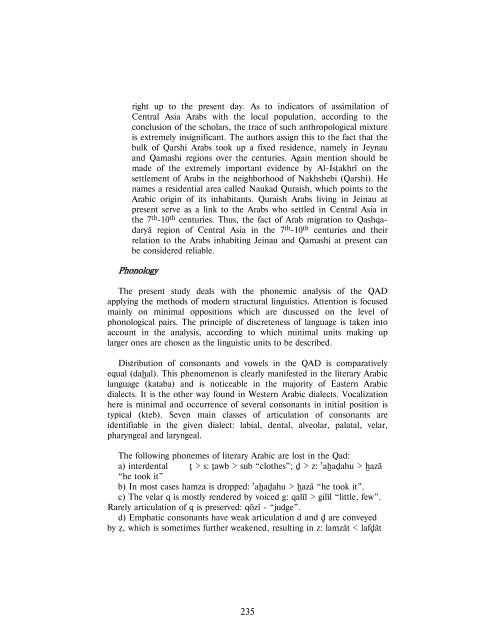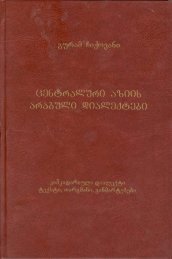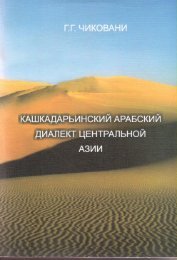You also want an ePaper? Increase the reach of your titles
YUMPU automatically turns print PDFs into web optimized ePapers that Google loves.
ight up to the present day. As to indicators of assimilation of<br />
Central Asia Arabs with the local population, according to the<br />
conclusion of the scholars, the trace of such anthropological mixture<br />
is extremely insignificant. The authors assign this to the fact that the<br />
bulk of Qarshi Arabs took up a fixed residence, namely in Jeynau<br />
and Qamashi regions over the centuries. Again mention should be<br />
made of the extremely important evidence by Al-Isãakhr× on the<br />
settlement of Arabs in the neighborhood of Nakhshebi (Qarshi). He<br />
names a residential area called Naukad Quraish, which points to the<br />
Arabic origin of its inhabitants. Quraish Arabs living in Jeinau at<br />
present serve as a link to the Arabs who settled in Central Asia in<br />
the 7 th -10 th centuries. Thus, the fact of Arab migration to QashqadaryÁ<br />
region of Central Asia in the 7 th -10 th centuries and their<br />
relation to the Arabs inhabiting Jeinau and Qamashi at present can<br />
be considered reliable.<br />
Phonology<br />
The present study deals with the phonemic analysis of the QAD<br />
applying the methods of modern structural linguistics. Attention is focused<br />
mainly on minimal oppositions which are duscussed on the level of<br />
phonological pairs. The principle of discreteness of language is taken into<br />
account in the analysis, according to which minimal units making up<br />
larger ones are chosen as the linguistic units to be described.<br />
Distribution of consonants and vowels in the QAD is comparatively<br />
equal (daÕal). This phenomenon is clearly manifested in the literary Arabic<br />
language (kataba) and is noticeable in the majority of Eastern Arabic<br />
dialects. It is the other way found in Western Arabic dialects. Vocalization<br />
here is minimal and occurrence of several consonants in initial position is<br />
typical (kteb). Seven main classes of articulation of consonants are<br />
identifiable in the given dialect: labial, dental, alveolar, palatal, velar,<br />
pharyngeal and laryngeal.<br />
The following phonemes of literary Arabic are lost in the Qad:<br />
a) interdental ä > s: äawb > sub “clothes”; Ë > z: öaÕaËahu > ÕazÁ<br />
“he took it”<br />
b) In most cases hamza is dropped: öaÕaËahu > ÕazÁ “he took it”.<br />
c) The velar q is mostly rendered by voiced g: qal×l > gil×l “little, few”.<br />
Rarely articulation of q is preserved: qÝz× - “judge”.<br />
d) Emphatic consonants have weak articulation d and Ì are conveyed<br />
by ì, which is sometimes further weakened, resulting in z: lamzÁt < lafÌÁt<br />
235





